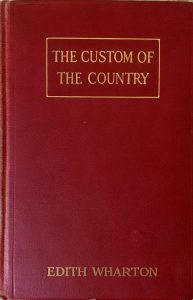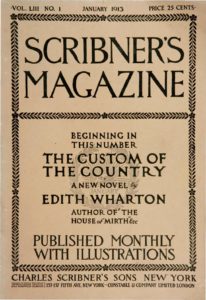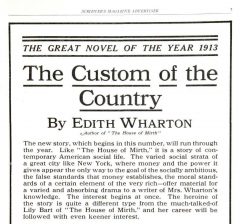Edith Wharton’s The Custom of the Country
 “If Undine Spragg, the heroine of Wharton’s novel ‘The Custom of the Country’, were alive today, she would have a million followers on Instagram…” Jia Tolentino, The New Yorker.
“If Undine Spragg, the heroine of Wharton’s novel ‘The Custom of the Country’, were alive today, she would have a million followers on Instagram…” Jia Tolentino, The New Yorker.
Edith Wharton’s The Custom of the Country is this month’s T Magazine book club selection so we wanted to share a bit of background about this “tragicomedy of manners.” And be sure to join the T Magazine virtual discussion with novelist Claire Messud on Jan. 28.
The Custom of the County (1913)
Wharton wrote many of her books quickly; she completed her Pulitzer Prize-winning novel, The Age of Innocence, in barely six months. However, The Custom of the Country took nearly six years, and as Wharton biographer R.W.B Lewis noted, “this novel, arguably the most powerful Edith Wharton ever wrote, was also the one that suffered most from interruptions.”
Wharton worked on Custom from about 1908 to 1913 while her life was in considerable turmoil. Her marriage was disintegrating as her husband Teddy’s mental health deteriorated. In 1907 she met the charming, yet mercurial, Morton Fullerton, with whom she had a passionate, volatile affair. She sold The Mount, her home in Lenox, MA, in 1911, separated from her husband, and moved permanently to France. In 1913 she divorced Teddy, ending their marriage of 28 years. She was also involved in a sometimes bitter dispute with her longtime publisher Scribner’s, eventually changing to Appleton’s. Yet while coping with these business, literary, and emotional issues, she managed to publish two volumes of short stories, one of poetry, a travel book, and two other novels, including one of her masterpieces, Ethan Frome.

The Custom of the Country follows the fortunes of Undine Spragg, a beauty from Apex, a rough-edged Midwestern town far from the sophisticated world of New York City. Undine aims high, as she uses her native wit and sexual power to marry, multiple times, into the elites of both New York and Europe. Undine is ruthless, superficial, grasping, selfish, and manipulative. Yet she is also ambitious, observant, and adaptable, a quick learner who masters the levers of power available to her and uses them to achieve her goals.
Why did Wharton have so much trouble finishing this novel? It is impossible to know the answer to that question, but she may have been struggling to balance the elements of satire and realism, debating how far she could go with the character of Undine Spragg without alienating her readers. Perhaps her own divorce made it difficult to find the right tone for Undine’s multiple marriages and divorces? Edith was still struggling with the final chapters of the book, when the first installment appeared in Scribner’s Magazine in January, 1913, and created great buzz, “Undine is making the press ring” she wrote a friend.
When the completed novel came out in September 1913, critical reception was mixed. British reviewers were generally more positive, praising its satirical qualities, while criticizing Undine as “a mere monster of vulgarity.” Henry James, who rarely commented on Wharton’s works publicly, praised its “particular fine asperity.” Some American reviews were quite harsh, The Boston Transcript felt the book was “decidedly beneath” her other work and that she seemed to be writing to shock rather than convince. According to Sir Kenneth Clark, when Wharton was nominated for a Nobel Prize for Literature in 1927 the Swedish Nobel committee found this novel too cynical and dropped Wharton from consideration.

Wharton counted it among her best.
However, unlike her other major novels The House of Mirth or The Age of Innocence there were no offers for film or dramatic adaptations. Indeed, outside of a 1984 adaptation by Jane Stanton Hitchcock which opened at The Mount, and ran briefly off-Broadway, there has been no major adaptation of Custom, which is just one reason for the anticipation surrounding the upcoming Sofia Coppola project.
“Undine Spragg is my favorite literary anti-heroine and I’m excited to bring her to the screen for the first time.” Sophia Coppola
Why is this novel often overlooked when Wharton’s masterpieces are listed? Why doesn’t it match Ethan Frome, The Age of Innocence, or The House of Mirth in the public imagination? Is this a book and a heroine more appreciated today than in 1913?
“This novel is full of brilliantly perceptive comments on family and marriage, on women’s education, on American customs and European customs, and on the influence of American capitalism and commerce upon American culture. Where Henry James dimly suggests, Wharton analyses and illustrates. She knows the world in a way that few novelists do, and it is a privilege to see the world in her company. I would have liked to hear her comments on the arid and sumptuous wastes of the New Jersey shopping mall.” Margaret Drabble, The Guardian
